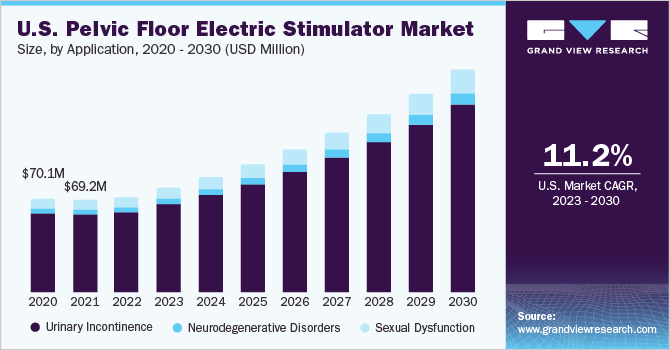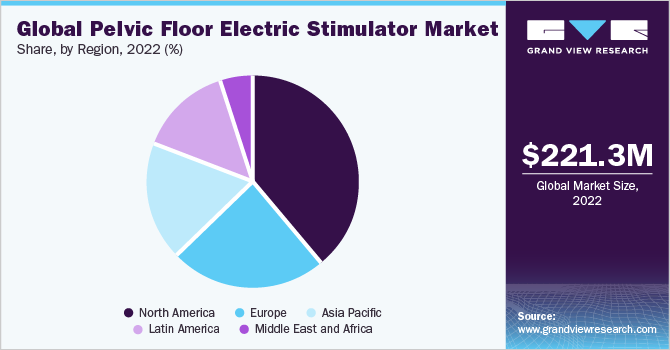- Home
- »
- Medical Devices
- »
-
Pelvic Floor Electric Stimulator Market Analysis Report, 2030GVR Report cover
![Pelvic Floor Electric Stimulator Market Size, Share & Trends Report]()
Pelvic Floor Electric Stimulator Market Size, Share & Trends Analysis Report By Application (UI, Neurodegenerative Disorders, Sexual Dysfunction), By Region (North America, Asia Pacific), And Segment Forecasts, 2023 - 2030
- Report ID: GVR-4-68038-024-8
- Number of Report Pages: 120
- Format: PDF, Horizon Databook
- Historical Range: 2018 - 2021
- Forecast Period: 2023 - 2030
- Industry: Healthcare
Market Size & Trends
The global pelvic floor electric stimulator market size was valued at USD 221.31 million in 2022 and is expected to grow at a compound annual growth rate (CAGR) of 11.9% from 2023 to 2030. The high prevalence of Urinary Incontinence (UI), increasing awareness initiatives by various government & non-profit organizations, as well as rising technological investments are the most significant growth drivers for this market. In addition, the rising prevalence of neurodegenerative disorders, the growing geriatric population, the rising demand for home healthcare, and the increasing use of medical sensors in various treatments are further expected to boost the market growth. Pelvic floor electric stimulator provides neuromuscular electrical stimulation through the pelvic floor for strengthening pelvic floor muscles.

It is delivered generally by anal or vaginal probes connected to an external pulse generator. The method of pelvic floor electric stimulation varies according to various parameters, such as stimulus frequency (Hz), amplitude (mA) and stimulus intensity, number of treatment days in a week, length of each treatment session, location, and clinic or home settings. This device is recommended for patients suffering from urologic disorders, such as urinary retention, cystitis, benign prostatic hyperplasia, and kidney stones. Doctors majorly recommend this product to the patient suffering from urinary issues.Moreover, a rapid rise in the geriatric population is also one of the key factors responsible for the increasing product demand as they are at higher risk of UI.
As per the American Society of Nephrology, urologic diseases are the third-most common concern among the geriatric population, and these account for approximately around 47.0% of physician visits. Similarly, according to Phoenix Physical Therapy, 200 million people are affected by UI worldwide. Moreover, the rising elderly population in the Asia Pacific region, especially in countries, such as Japan, India, and China, is expected to drive the market during the forecast period. As per the estimations reported by the World Bank, in 2019, more than 28.0% of the population in Japan is over the age of 65 years. Thus, an increasing number of patients suffering from urinary incontinence is anticipated to boost the demand for pelvic floor electric stimulators, thus contributing to the market growth over the forecast period.
Furthermore, initiatives for increasing awareness are anticipated to boost market growth. For instance, the Australian government has launched the Continence Aids Payment Scheme (CAPS). This scheme supports patients suffering from permanent or severe incontinence problems with their incontinence needs. They also launched the National Continence Management Program, which aims to raise awareness regarding various bowel and bladder health problems. In addition, professionals, such as urogynecologists, urologists, gynecologists, and nurses as well asmany professional organizations have actively participated to promote awareness about continence in all care settings. For instance, the International Continence Society (ICS) established the Continence Promotion Committee (CPC) to promote education, services, and public awareness programs about incontinence across the world.
Thus, the growing number of awareness programs, regarding urinary diseases and the rising prevalence of UI, by various government and non-profit organizations are some of the factors driving the market growth.Countries, such as the U.S. and Canada, have witnessed a high prevalence rate of UI among the elderly population. In this region, UI has a high prevalence rate and is discussed more openly in media, newspapers, and television commercials. According to the American Academy of Family Physicians (2016), more than 250,000 BPH-related surgical procedures are performed in the U.S. every year. This condition may occur due to trauma or injury to the penis, urethra, or bladder and is associated with pregnancy.
Similarly, according to the Canadian Urological Association in 2017, bladder cancer is the fifth-most common type of cancer in Canada. These factors are expected to boost the product demand. Furthermore, the rising prevalence of hypertension and diabetes is one of the major factors for the increasing prevalence of urinary incontinence, which in turn is driving the market. According to the report published by the WHO in 2019, around 1.13 billion people worldwide have hypertension. Diabetes is the primary cause of advanced renal failure, followed by hypertension, which is estimated to affect around 1.0 billion individuals globally. Thus, the increasingnumber of patients suffering from end-stage renal diseases is anticipated to boostproduct demand, thereby boosting market growth over the forecast period.
Application Insights
Based on applications, the market is segmented into UI, neurodegenerative disorders, and sexual dysfunction.The UI segment dominated the market with a share of 84.9% in 2022 owing to the high prevalence of stress & urge incontinence andvarious product launches by key players in the market. The geriatric population and pregnant women are more prone to UI. According to a study published in NCBI, the prevalence of UI in pregnant women ranges from 32.00% to 64.00%. In addition, as per the Office on Women’s Health (U.S. Department of Health and Human Services), around 4 in 10 women get some type of UI during pregnancy.
This is anticipated to boost the growth of this segment.However, the sexual dysfunction segment is expected to grow at the highest CAGR of 12.4% from 2023 to 2030. Products introduced by the top players in the market, increasing awareness about the treatment of sexual dysfunction through pelvic floor electric stimulators, and the rising prevalence of sexual dysfunction are a few factors that may drive market growth in the future. For instance, according to the University of Wisconsin Foundation (School of Medicine and Public Health), around 5% of men aged above 40 years have Erectile Dysfunction (ED).
Regional Insights
North America dominated the market with a share of 38.9% in 2022. This dominance can be attributed to factors, such as increasing incidence of neurodegenerative disorders, rising geriatric population, increasing prevalence of sexual dysfunction, and the presence of many players in this region. According to the Parkinson’s Foundation, around 60,000 people in the U.S. are diagnosed with Parkinson’s disease every year. As per a report by the U.S. Census Bureau, around 78.0 million people will be aged 65 years and older by 2035. In addition, according to the Alzheimer Society Canada, around 25,000 new cases of Alzheimer’s diseaseare diagnosed every year and it is expected to increase to 9, 37,000 by 2031.

However, Asia Pacific is expected to lead the market from 2023 to 2030 owing to various factors, such as increasing government spending, increasing investments by key players, and awareness programs by various organizations. For instance, in India, the Urological Society of India drafted guidelines for spreading awareness about urinary incontinence in India. Similarly, the Korean Incontinence Society, in South Korea, is working towards spreading awareness about urology issues related to the pelvic floor and lower urinary tract.
Key Companies & Market Share Insights
Key companies launch new products to strengthen their product portfolios and offer diverse technologically advanced & innovative products to their customers. It is the most prominently adopted strategy by companies for attracting more customers. Moreover, several players engage in mergers and acquisitions to strengthen their industry position. This strategy enables companies to increase their capabilities, expand their product portfolios, and improve their competencies. Players, such as Laborie, Inc. and Athena Feminine Technologies, Inc., are using these strategies to gain more market share. For instance, in February 2020, Laborie acquired Clinical Innovations-a leading provider of medical devices for Labor & Delivery and Neonatal Intensive Care Unit specialties-for an enterprise value of USD 525 million. Such strategies are expected to strengthen their foothold in the industry.Some of the prominent players in the global pelvic floor electric stimulator market include:
-
Zynex Inc.
-
TensCare Ltd.
-
Verity Medical Ltd.
-
InControl Medical
-
The Prometheus Group
-
Laborie, Inc.
-
ActivLife Technologies
-
Athena Feminine Technologies
-
Atlantic Therapeutics
-
Renovia Inc.
Pelvic Floor Electric Stimulator Market Report Scope
Report Attribute
Details
Market size value in 2023
USD 246.02 million
Revenue forecast in 2030
USD 539.38 million
Growth rate
CAGR of 11.9% from 2023 to 2030
Base year for estimation
2022
Historical data
2018 - 2021
Forecast period
2023 - 2030
Report updated
June 2023
Quantitative units
Revenue in USD million and CAGR from 2023 to 2030
Report coverage
Revenue forecast, company ranking, competitive landscape, growth factors, and trends
Segments covered
Application, region
Regional scope
North America; Europe; Asia Pacific; Latin America; MEA
Country scope
U.S.; Canada; UK; Germany; France; Italy; Spain; Denmark; Sweden; Norway; China; India; Japan; Australia; South Korea; Thailand; Mexico; Brazil; Argentina; South Africa; Saudi Arabia; UAE; Kuwait
Key companies profiled
Zynex Inc.; TensCare Ltd.; Verity Medical Ltd.; InControl Medical; Prometheus Group; Laborie, Inc.; ActivLife Technologies; Athena Feminine Technologies; Atlantic Therapeutics; Renovia Inc.
Customization scope
Free report customization (equivalent up to 8 analysts working days) with purchase. Addition or alteration to country, regional & segment scope
Pricing and purchase options
Avail customized purchase options to meet your exact research needs. Explore purchase options
Global Pelvic Floor Electric Stimulator Market Report Segmentation
This report forecasts revenue growth and provides an analysis of the latest trends in each of the sub-segments from 2018 to 2030. For this report, Grand View Research has segmented the global pelvic floor electric stimulator market based on application and region:

-
Application Outlook (Revenue, USD Million, 2018 - 2030)
-
Urinary Incontinence
-
Neurodegenerative Disorders
-
Sexual Dysfunction
-
-
Regional Outlook (Revenue, USD Million, 2018 - 2030)
-
North America
-
U.S.
-
Canada
-
-
Europe
-
Germany
-
UK
-
France
-
Italy
-
Spain
-
Denmark
-
Sweden
-
Norway
-
-
Asia Pacific
-
Japan
-
China
-
India
-
Australia
-
South Korea
-
Thailand
-
-
Latin America
-
Brazil
-
Mexico
-
Argentina
-
-
Middle East and Africa (MEA)
-
South Africa
-
Saudi Arabia
-
UAE
-
Kuwait
-
-
Frequently Asked Questions About This Report
b. Key factors that are driving the pelvic floor electric stimulator market growth include the increasing prevalence of urinary incontinence, technological advancements, and a rising number of patients suffering from overactive bladder.
b. The global pelvic floor electric stimulator market size was valued at USD 221.31 million in 2022 and is expected to reach USD 246.02 million in 2023.
b. The global pelvic floor electric stimulator market is expected to grow at a compound annual growth rate of 11.9% from 2023 to 2030 to reach USD 539.38 million in 2030.
b. North America dominated the pelvic floor electric stimulator market with a share of 38.9% in 2022. This is attributable to increasing supportive government initiatives, favorable reimbursement policies, and increasing awareness about urinary incontinence in the general public in the region.
b. Key companies operating in the market are Zynex Inc, TensCare Ltd, Verity Medical Ltd, Tic Medizintechnik GmbH, Everyway Medical Instruments Co, InControl Medical Limited, The Prometheus Group, Hollister Incorporated, and Laborie.
b. The UI segment led the global pelvic floor electric stimulator market with a share of 84.87% in 2020.
Share this report with your colleague or friend.
![gvr icn]()
NEED A CUSTOM REPORT?
We can customize every report - free of charge - including purchasing stand-alone sections or country-level reports, as well as offer affordable discounts for start-ups & universities. Contact us now
![Certified Icon]()
We are GDPR and CCPA compliant! Your transaction & personal information is safe and secure. For more details, please read our privacy policy.
We are committed towards customer satisfaction, and quality service.
"The quality of research they have done for us has been excellent."





